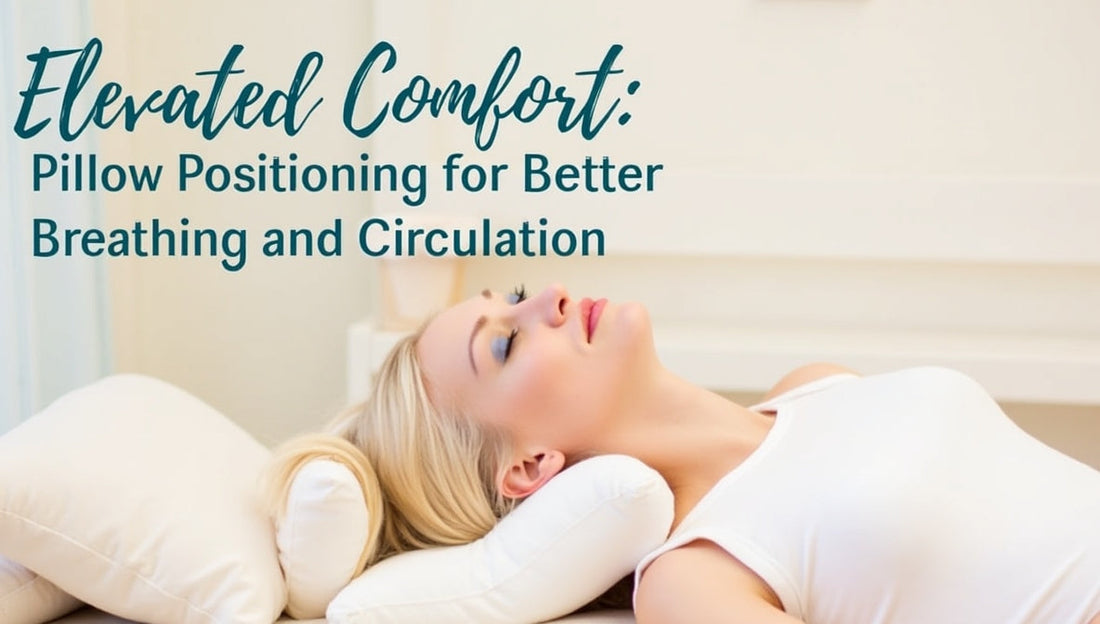
Elevated Comfort: Pillow Positioning for Better Breathing and Circulation
Share
Elevated Comfort: Pillow Positioning for Better Breathing and Circulation 💤💨
When it comes to truly restorative sleep, comfort goes beyond plush fabrics and cozy warmth. How you position your pillow can have a profound impact on your breathing, blood flow, and overall sleep quality. In this deep dive, we’ll explore why elevating your head and upper torso matters, how strategic pillow placement optimizes airway alignment and circulation, and practical tips for unlocking elevated comfort every night.
The Science of Airway Alignment
Your airway is essentially a soft tube that runs from your nose and mouth down into your lungs. When you lie flat on your back, the tongue and soft tissues in your throat can collapse slightly backward, narrowing this passage. This subtle restriction not only increases snoring but may also interrupt airflow enough to cause restless sleep.
Elevating your head by just 5–10° can help:
-
Open the airway by preventing soft tissue collapse
-
Reduce snoring intensity and frequency
-
Enhance oxygen exchange for deeper, more stable breathing
This slight incline mimics the position of your head when you’re seated upright—nature’s most efficient breathing posture.
Circulation: Beyond Just the Chest
Just as gravity affects breathing, it influences blood flow. When your head sits lower than your heart—especially if you sleep flat on your back—venous return (the flow of blood back to your heart) must work against gravity. A modest elevation:
-
Eases venous return, reducing pooling in the head and neck
-
Lowers intracranial pressure, which can help prevent morning headaches
-
Promotes lymphatic drainage, aiding in the removal of metabolic waste from brain tissues
For side sleepers, elevating the head can also relieve pressure on the jugular veins, improving cerebral circulation and reducing puffiness around the eyes.
Choosing the Right Elevation
Not all inclines are created equal. Too steep, and you’ll feel like you’re perched on a hill; too shallow, and you won’t notice the benefits. Here’s a quick guide:
| Sleep Position | Recommended Elevation Angle | Approximate Loft Increase |
|---|---|---|
| Back | 5°–7° | 3–5 cm |
| Side | 7°–10° | 5–8 cm |
These general ranges provide enough tilt to optimize airway and vascular alignment without introducing neck strain or sliding off your pillow.
Pillow Placement Strategies
-
Under-Head Wedge
A small, dense wedge foam under your standard pillow can add controlled elevation. Place the thicker end toward the top of the bed so your head rests higher than your shoulders. -
Stack-and-Splay for Side Sleepers
Rather than stacking two flat pillows, use one firm base pillow for elevation and a softer top pillow to cradle your head. The “splay” of the softer pillow fills the shoulder gap without over‑tilting your neck. -
Adjustable Inserts
Modular pillow systems let you insert or remove foam layers. Fine‑tune elevation by trial and error—add one layer at a time until your airway feels fully open and unencumbered. -
Torso Support
For those with mild acid reflux or chronic congestion, extending elevation to the upper torso (not just the head) can further improve comfort. A longer wedge under both head and shoulders keeps the entire chest area inclined.
Breathing Benefits for Allergy and Cold Sufferers
If you wake up congested, head elevation can be a game‑changer:
-
Sinus Drainage: Helps mucus flow downward and out, reducing nighttime blockages.
-
Reduced Post‑nasal Drip: Keeps throat tissues less irritated, cutting down coughing fits.
-
Easier Chest Clearance: Helps break up phlegm and improves comfort when coughing.
Even a modest 5 cm lift can noticeably ease breathing for allergy or cold sufferers, letting you drift back to sleep without constant nose‑blowing or coughing.
Circulatory Comfort for Snorers and Sleep Apnea
For those who snore or have mild obstructive sleep apnea, head elevation is a first‑line, non‑invasive adjustment:
-
Snoring: Elevation increases airway diameter, cutting down vibration of soft tissues.
-
Mild Apnea: For some, a small incline prevents full collapse of the airway, reducing apnea episodes without a CPAP machine.
Of course, anyone with moderate to severe apnea should consult a sleep specialist, but pillow positioning can still complement medical treatments.
Practical Tips for Implementing Gentle Elevation
-
Gradual Changes: Start with a low incline (3–4 cm) and increase until you feel airflow improve.
-
Combine with Neck Support: Use a contoured pillow to maintain cervical alignment even on an incline.
-
Test for Comfort: Sleep at each new elevation for 2–3 nights before making further adjustments—your body needs time to acclimate.
-
Maintain Core Support: Ensure your lower back and hips remain on a flat surface to prevent spinal misalignment.
Why AlignU Takes Pillow Positioning to the Next Level
While simple wedges and stacked pillows offer a taste of elevation benefits, they often sacrifice neck cradle or overall stability. The AlignU Pillow System delivers integrated, precision‑engineered elevation plus full‑body support:
-
Patented Wedge Base: Ergonomically angled to optimize both breathing and circulation without slipping.
-
Contoured Memory‑Foam Pillow: Maintains cervical curve even on an incline, preventing muscle strain.
-
Modular Torso Side‑Pillows: Extend elevation through the shoulders and upper torso for seamless chest incline.
-
Envelope‑Style Cover with Hidden Zipper: Keeps all layers securely in place and washable for hygiene.
With AlignU, you get a holistic elevation solution—improving not only airflow and blood flow but also spinal alignment, shoulder positioning, and overall comfort.
Ready for Elevated Comfort?
Discover how strategic pillow positioning can transform your sleep quality. Visit AlignU Sleep to learn more, explore our patent‑pending modular pillow system, and join the waitlist for exclusive early‑bird discounts. Your breath, your blood flow, and your mornings will thank you.
